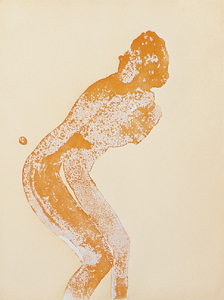![[Metroactive Arts]](/arts/gifs/art468.gif)
[ Arts Index | Silicon Valley | Metroactive Home | Archives ]

Figure Vigor: Nathan Oliveira's 2004 aquatint 'Dancer III' demonstrates the artist's continuing interest in the human form. Finding Form Nathan Oliveira's recent print show seeks to reveal the inner figure By Sarah Birnbaum BAY AREA artist Nathan Oliveira is known for his expressionistic paintings and prints of solitary figures in empty space. He might begin a piece by loosely sketching a model. Sometimes he starts by pushing paint around on a canvas and waits for the figure to emerge organically. But whatever the process, the goal is the same: He wants his work to reveal or express something about who we are on the inside. In an interview, the artist once remarked, "I would be so pleased if someone would look at one of [my] prints [or paintings] and say, 'You know, sometimes I feel like that.'" But I felt disappointed at "Essence of Form," the exhibition of Oliveira's recent prints in the Mohr Gallery at the Community School of Music and Arts at Finn Center in Mountain View. The work was uninspired and the setting made matters worse. The Mohr Gallery is, in fact, just a continuation of the lobby, with a corporate décor that only intensified the prints' already staid feel. Because the gallery can't accommodate all of the artwork from the exhibit, some of the prints are hung in a stuffy hallway between classroom doors (where it's impossible to shake the sensation that you're cutting class). The prints themselves lack vitality and are rather bland. That's not to say that they're not pretty, much as a meadow in soft focus is pretty. The reclining silhouette in the Orange County Nudes series evokes a peaceful landscape: She's all slopes and curves, all arched back and swelling hips, so that when you squint, her body looks like a mountain formation. She's filled in with bronze and orange ink. The colors pool and bleed together, in a way that reminded me of tie-dyed silk. This billowiness is an exception; all the other prints are very flat, which has something to do with the unusual technique Oliveira used to create the backgrounds: He coated the surface of the copper etching plate with a powdery solution, which he then heated so that the particles fuse to the plate and the liquid evaporates. When the plate is inked and printed, the result is a network of tiny polka dots (think of a bitmap) that resembles broad, flat fields of color that can fade from light to dark. This process is called aquatint because it imitates the look of watercolor washes, and Goya was perhaps its greatest practitioner. Goya wraps his figures in aquatint shadows that are dramatic and haunting. Aquatint is labor-intensive and difficult to pull off, and Oliveira executes it well. But his effort seems superfluous. Whereas Goya used aquatint to make his images more mysterious, in Oliveira's case, the technique doesn't contribute anything to the prints. Unlike Goya's work, and unlike Oliveira's own work from the late '50s, the prints in "Essence of Form" have no undercurrent of energy. They have no oomph.
Send a letter to the editor about this story to letters@metronews.com. [ Silicon Valley | Metroactive Home | Archives ]
|
From the March 9-15, 2005 issue of Metro, Silicon Valley's Weekly Newspaper.
Copyright © Metro Publishing Inc. Metroactive is affiliated with the Boulevards Network.
For more information about the San Jose/Silicon Valley area, visit sanjose.com.